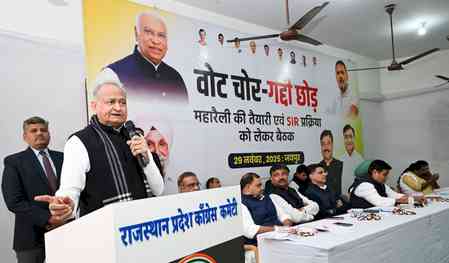Quotes of Industry on GST Reforms

Shenu Agarwal, MD & CEO, Ashok Leyland
“The GST rate reductions announced by the Hon’ble Finance Minister represent a forward-looking step towards simplifying India’s tax structure and accelerating economic momentum. The shift to a streamlined two-tier system of 5% and 18% will not only ease compliance but also bolster key sectors, uplift consumer sentiment, and reduce the financial burden on the common man. Crucially, this move will help mitigate the impact of the recently imposed US tariffs. The specific relief for the commercial vehicle industry is especially welcome. On one hand, it will spur freight traffic, and on the other, it will bring down the cost of buses and trucks, unleashing demand trajectory for commercial vehicles.”
Rajeev Gupta, Joint Managing Director of RSWM Ltd.
“We welcome the Government’s forward-looking GST reform, which will have a far-reaching impact on India’s economic growth by improving affordability, reducing working capital requirements, and boosting demand across industries. For the textile sector, this is a particularly transformative step. The reduction of GST on manmade fibre from 18% to 5% and on synthetic yarn from 12% to 5% will significantly strengthen the domestic textile industry, enhance competitiveness, and stimulate consumption. The revision of the apparel slab, raising the limit from ₹1,000 to ₹2,500, will provide a powerful boost to garments and apparel demand, thereby creating new opportunities across the textile value chain. At the same time, we believe that harmonizing GST on recycled polyester fiber and its raw material, PET bottles (18%), is an important area that needs attention to unlock the full potential of circular textiles. We remain committed to driving sustainable innovation, scaling domestic production, and contributing to India’s journey towards Viksit Bharat @2047”.
Karishmah Siingh, President - Sales, Marketing & CRM, Sattva Group
“This GST reduction on cement represents a pivotal reform that fundamentally shifts the affordability equation for Indian homebuyers. With ₹12-15 per square foot in direct savings, builders now have the flexibility to pass on meaningful cost reductions to end consumers, making homeownership a realistic aspiration rather than a distant dream. What's particularly compelling is how this creates a virtuous cycle as construction costs become more manageable, developers can price their projects more competitively, which in turn encourages fence-sitting buyers to move from aspiration to action. The immediate market enthusiasm reflects a broader confidence that we're entering a phase where homebuying decisions will be driven by genuine affordability rather than constrained by inflated input costs. This reform essentially removes a major psychological barrier for homebuyers who have been waiting for the right moment to invest in their future.”
Samir Jasuja, Founder & CEO, PropEquity
“The rationalisation of GST rates by the government is a welcome move towards reducing compliance and thereby ease of doing business in the country. The reduction in rates across a host of items will give a spur to consumption, savings and investment by households, in turn enabling them to reduce their EMI burdens. This coupled with falling home loan rates will bring the much-needed cheer in the upcoming festive season and beyond. The overall impact of this move will translate into higher GST collections, more government spending and higher economic growth.”
FADA President Mr C S Vigneshwar
"The 56th GST Council meeting marks a watershed moment for India’s automobile retail industry. FADA warmly welcomes the bold and progressive reforms which simplify the tax structure, lower rates for mass mobility, and bring consensus across all States. This is a decisive step that will boost affordability, spur demand, and make India’s mobility ecosystem stronger and more inclusive.
We thank the Hon’ble Prime Minister, Finance Minister, and the GST Council for taking such a courageous decision with unanimity. As the country heads into the peak festive season, glitch-free implementation will be the key to ensuring that the benefits seamlessly reach customers. One area that may needs earliest clarification is about levy and treatment of cess balances currently lying in dealers’ books, so that there is no ambiguity during transition.
FADA remains committed to working closely with the Government and GST Council to make GST 2.0 a model reform — simple, transparent and growth-oriented for both industry and consumers."
Naval Kagalwala, COO and Product Head, Shriram Wealth Ltd
"The GST Council’s move to rationalise tax slabs is a clear signal of India’s shift towards simplicity, transparency, predictability, ease of doing business and thus strengthening the foundation for a long-term structural growth. For affluent households, the higher levy on luxury categories will modestly increase lifestyle costs, but the broader economy stands to benefit from lower taxation on everyday goods. The balance between boosting demand and aligning luxury & sin consumption with higher tax incidence is measured, with a likely net revenue impact of Rs.48,000 crs. This fiscal impact should be manageable from the likely boost in demand and other avenues. This should also create fresh opportunities across multiple sectors eg. FMCG, healthcare, housing. Overall, this change should help drive growth in domestic consumption."
Ankur Jalan, CEO, Golden Growth Fund (GGF), a category II Real Estate focused Alternative Investment Fund (AIF):
“The GST rate rationalisation is expected to streamline compliance across industries, enhance operational efficiency, and strengthen tax collections. By stimulating demand in core sectors such as real estate, infrastructure, agriculture, automobiles, healthcare, and education—key pillars of India’s economy—this timely reform is set to boost overall economic activity. It also comes at an opportune moment, paving the way for increased consumption during the upcoming festive season.”
Bengaluru-based real estate developer Sanjeevini Group Chairman and Founder, Umesh Gowda H.A:
“The next-gen GST reforms aided by declining interest rates will spur consumption demand, bolster the real estate sector and give a boost to the economy. The upcoming festive season may see developers pass on some benefits to the homebuyers to accelerate sales in view of a weak first half of 2025.”
Vijay Harsh Jha, Founder and CEO of property brokerage firm VS Realtors:
“The cut in GST rate on cement will provide the much-needed fillip to the affordable housing sector, which off late has seen considerable reduction in supply with developers refraining from launching new project due to rising cost and reduced viability. This move will further accelerate the ongoing infrastructure development providing a broader stimulus to the economy and India’s growth story.”
Kamal Khetan, Chairman & Managing Director, Sunteck Realty, Ltd.-
“The GST cut on cement and other construction materials is a landmark step that directly lowers the cost of construction. This reduction enables developers to maintain price stability and pass on the benefit to homebuyers through improved affordability. It will also support healthier project economics and encourage further investment into housing and urban infrastructure.”
Amit Mahajan, Director, Paras Defence & Space Technologies Ltd
"With GST reforms reducing GST on Drones and exempting Military Drones and Drone components such as Batteries is a clear indication that Drones are being recognized as a platform of the future. Be it commercial applications or military, impact of drones on our lives is inevitable and the new reforms will boost the industry and encourage technology development in this space. The new reforms have entrusted faith in Drone Platforms to become a high volume industry with enabled supply chain."
Naveen Chandra Jha, MD & CEO, SBI General Insurance
“The GST Council’s decision to reduce tax on the healthcare sector marks a transformative step toward greater affordability and inclusivity. At a time when India’s healthcare market is poised for significant growth, this reform acts as a timely catalyst to strengthen the ecosystem by addressing one of the biggest barriers to quality healthcare affordability.
Whether it is making life-saving drugs more accessible or lowering the cost of health insurance, the move directly tackles a long-standing challenge and will enable millions of families to take a crucial step toward financial and medical security.
For the health insurance sector, this change comes at a pivotal moment. As India’s healthcare needs expand and medical risks evolve, the importance of universal health coverage has never been more evident. Health insurance is not merely a financial product, it is a lifeline that protects families, supports well-being, and builds resilience against future uncertainties.
At SBI General Insurance, we view this reform as a strong driver in accelerating India’s journey toward ‘Insurance for All by 2047.’ Our focus will be on leveraging this opportunity to design affordable, accessible, and customer-centric health insurance solutions, while expanding our reach across rural and semi-urban India.”
Dr K Rathnam, CEO of Milky Mist Dairy
"We welcome the Government of India’s decision to reduce the Goods and Services Tax (GST) on a wide range of dairy products to 5% — a reform that will have far-reaching benefits for consumers, farmers, and the dairy industry at large.
For households across India, this move will make nutritious, value-added dairy products such as cheese, butter, ghee, paneer, and milk-based beverages more affordable and accessible. For the dairy sector, it is a timely boost that will stimulate demand, encourage innovation, and strengthen the formal, organised dairy ecosystem.
At Milky Mist, we see this as more than a tax reform — it is a catalyst for inclusive growth. Lower GST will help expand the market for high-quality, packaged dairy products, enabling more consumers to shift from loose, unregulated supply chains to safe, standardised offerings. This transition not only benefits public health but also creates stronger, more stable demand for the millions of dairy farmers who form the backbone of our industry.
The GST reduction also aligns with India’s nutritional goals by making protein-rich and calcium-rich foods more affordable, especially in rural and semi-urban markets. As an industry, we now have an opportunity — and a responsibility — to reinvest these gains into farmer training, sustainable sourcing, cold chain infrastructure, and product innovation that meets evolving consumer needs.
Milky Mist remains committed to passing on the benefits of this reform to our customers while continuing to champion quality, transparency, and value in every product we deliver. Together, as an industry, we can leverage this policy change to drive both economic and nutritional progress for the nation."
Suneeta Reddy, Managing Director of Apollo Hospitals Enterprise Limited
"We welcome the rationalization of GST, which comes as a corollary to the tax cuts and 100% FDI in insurance announced in the Union Budget earlier this year. Together, this provides a valuable platform to make healthcare more accessible and affordable. The reduction in GST rates of life-saving and other drugs, and the standardization of GST for consumables are very positive steps both for the patient and for the sector. India’s aspiration for more health infrastructure will be well-served with the reduction in GST for construction inputs like cement, fly ash bricks, marble and granite. Above all, we believe this will enable many more Indians to purchase health insurance and insurers will serve a larger insured pool. This will truly unlock access to high-quality healthcare for India."


 City Air News
City Air News 










